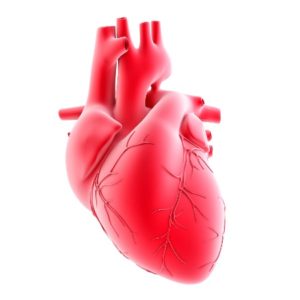Our muscle of the month is the heart. You might be thinking the heart is an organ, rather than a muscle, but an organ is defined as “a part of an organism that is typically self-contained and has a specific vital function.” A muscle is defined as “a bundle of fibrous tissues in a human or animal body with the ability to contract.” Your heart actually meets both of these qualifiers and is one of the most important pieces of your body puzzle, as it continuously contracts to circulate blood to deliver oxygen and nutrients as well as remove waste from your entire body.

How Many Times Does Your Heart Beat?
If you use an average of 80 beats per minute, your heart beats about 4,800 times per hour. That’s a whopping 115,200 times per day. Over the course of a year, your heart would beat about 42,048,000 times! If you live to be 80 years old, your heart would have beaten approximately 3,363,840,000 times! That’s over 3 billion heartbeats! What a muscle!
Exercise Tips for a Healthy Heart
The American Heart Association says, “physical activity is anything that makes you move your body and burn calories.” This includes walking, biking, swimming, playing sports or climbing stairs. For overall cardiovascular health, the AHA Recommends:
- At least 30 minutes of moderate-intensity aerobic activity at least 5 days a week or
- At least 25 minutes of vigorous aerobic activity at least 3 days a week, and
- Moderate to high-intensity muscle-strengthening activity at least 2 days a week
For lowering blood pressure and cholesterol, it is recommended to do an average of 40 minutes of moderate to vigorous intensity aerobic activity at least 3-4 days a week.
HI-YO Water Workout for a Healthy Heart and Weight Loss
Not only does HIIT improve cardiovascular function in young and healthy individuals, it has been found to be almost twice as effective at improving heart health in individuals diagnosed with cardiovascular disease and/or having identified cardiovascular risk factors.
There are a few important considerations that guide any HI-YO workout. A proper warm-up is essential and should include:
- Exaggerated range of motion to allow for dynamic stretching
- Basic movement patterns that will be included in the work phase
- 6 Directions: Forward, backward, side to side and right and left rotational moves
The work phase is the interval phase alternating between HI (high intensity) and YO (recovery segments). The duration of each interval depends on your fitness level and training goals. To get started, give yourself equal or more recovery time after each high intensity segment. As you become more comfortable, try sneaking in short bouts of 15-20 seconds of higher intensity bursts within the work segment. These short bursts will really get your heart pumping!
The HI-YO training format can also be applied in deep water. An example of a deep water HI-YO workout might look something like this:
1.) Warm-Up:
- Jogging using 7 different foot positions.
2.) Conditioning (repeat each set 2-3 times):
- Cross body leg reach (YO-60 seconds) paired with Flutter Kicks (HI-30 seconds)
- Kneeling travel (YO-60 seconds) paired with Tucks (HI-30 seconds)
- Alternating side lunge (YO-30 seconds) paired with Ski with Cross Body Reach (HI-15 seconds)
- Run through each of these segments again
3.) Warm-Down:
- To finish the workout, take each of the exercises you have been learning and perform them in super slow motion.
- Ski, kick, tuck and lunge as slow as you can go for an opportunity to stretch and return the heart rate to pre-exercise rate.
Watch the video below for a visual demonstration of all of these exercises.
Ready to dive into heart-healthy water workouts? Wavemakers includes our 28-day Everyday Cardio program, giving you total body conditioning with less joint stress.
Become a member today and start your heart-healthy, feel-better journey.
